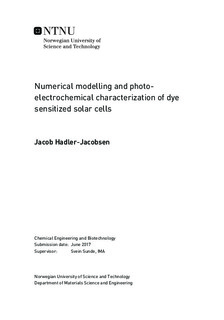| dc.description.abstract | Current-potential characteristics were recorded, and intensity modulated photocurrent spectroscopy (IMPS), intensity modulated photovoltage spectroscopy (IMVS), and electrochemical impedance spectroscopy (EIS) was performed on two DSSC s. The two DSSC s were made identical, except that one was made with a well-known ruthenium dye (N719), and the other one with a novel ruthenium-free purely organic dye (AFB5-098, abbreviated AFB8). Anta et al. s numerical version of the diffusion model[1] was extended to include small amplitude perturbation and used to interpret the experimental data. This made a basis from which the solar cells could be characterized and compared, and suggestions for ways to improve the cells were presented.
The extended numerical model reproduced both the experimental IV-characteristic and the IMPS and IMVS spectra with good, if not perfect, accuracy. It was further revealed by the model that the N719- DSSC had poor charge capture efficiency, but excellent injection and absorption efficiency. The AFB8-DSSC on the other hand, had excellent charge collection efficiency, but seemed to have sub-optimal injection and/or absorbance efficiency. There were strong indications that the N719-DSSC could benefit significantly from decreased thickness of the titanium dioxide layer and quicker diffusion. There were some indications that the AFB8- DSSC could increase its efficiency moderately from a thicker titanium dioxide layer. Both cells would gain a higher potential from slower recombination, while the N719-DSSC would also gain increased current density from it. All in all, the combination of the numerical modelling and the photo-electrochemical experimental work was successful at both characterizing and suggesting ways to optimize the solar cells. | en |

